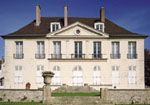 From medieval castles to the folly architecture of the eighteenth century, Lords who exerted their power left their mark on the region. Visible traces of this heritage are very much part of the scenery and several of these stately homes have become the city Halls in the different localities. Discover the castles and mansions of the princes of Orléans in Le Raincy, Villemomble castle, Gournay castle, Bagnolet castle, "Le Château Bleu" in Tremblay-en-France ; Saint-Ouen castle where Madame de Staël resided. The different follies were transformed into country houses such as the house of Rose Bertin in Epinay-sur-Seine and château des Cèdres in Montfermeil. And many more…
From medieval castles to the folly architecture of the eighteenth century, Lords who exerted their power left their mark on the region. Visible traces of this heritage are very much part of the scenery and several of these stately homes have become the city Halls in the different localities. Discover the castles and mansions of the princes of Orléans in Le Raincy, Villemomble castle, Gournay castle, Bagnolet castle, "Le Château Bleu" in Tremblay-en-France ; Saint-Ouen castle where Madame de Staël resided. The different follies were transformed into country houses such as the house of Rose Bertin in Epinay-sur-Seine and château des Cèdres in Montfermeil. And many more…
Fortified castles were first small fortresses built perched high on artificial hillocks, mounds of earth, just like the specimen which can be seen in Drancy in the Park "La Doucette". Most of the fortified castles were rebuilt according to new architectural criteria. Henceforth, fortified houses were surrounded by a circular enclosure. Fortification remains from the 12th century can still be seen in rue des Fossés in the "Vieux Pays" in Tremblay-en-France. Providing military support and a safe haven, the castle was also the pivotal point of a network of outbuildings to become the core of a rural economy. A Seigneurial residence, the castle favored the development of the town as well as the foundation of a new fortified city.
In architecture, classicism is characterized by the compilation of various existing elements. François Mansart was the first to bring them together to make one, individual style. Henceforth, single dwellings prevailed. You can find example of these in the towns of: Bagnolet, Gournay sur Marne, Gagny, Tremblay en France and Blanc Mesnil.
In the eighteenth century, Parisians moved out of the walls of the capital to build their houses in the countryside. Because of their initial purpose, these little houses were known as "ollies". Indeed, follies were sometimes used to house secret lovers or less discreet antics. The follies became very fashionable among Parisians who could afford to buy them. They became country houses and even main homes such as the House of Rose Bertin in Epinay-sur-Seine or Villemomble castle. These follies often looked like castles such as the one located in Sevran. Noblemen restored their homes according to the new concept or replaced them by new ones.
Senior judges acquired these domains and built their house there. It was the Attorney General of the Chamber of Accounts who built the castle “château des Cèdres” in Montfermeil. War veterans and diplomats prepared to retire to these follies. Many of these castles had financial backing such as the one located in Epinay-sur-Seine built by the marquis du Terrail, the son of a rich business man, or by men of the arts, such as the "château de Montguichet", in Gagny, the property of a doctor. Shopkeepers residents were not less extravagant such as the old mansion belonging to a horse dealer in Le Bourget. Castles and mansions built in the eighteenth century are numerous in Seine Saint Denis. They are well preserved; listed, restored and many of them have now become the administrative center or the town hall of their locality.
Château Puységur in Clichy-sous-Bois, current City Hall (facade from the 19th century)